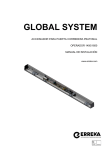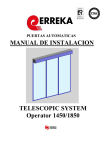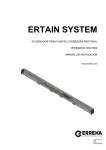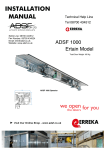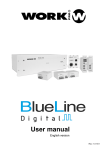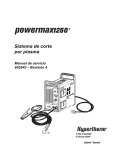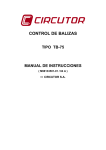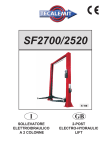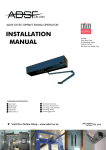Download INSTALLATION MANUAL - ADSF
Transcript
INSTALLATION MANUAL Technical Help Line Tel 08700 434512 Sales Line: 08700 434512 Fax Number: 08700 434524 Email: [email protected] Website: www.adsf.co.uk : ADSF 3000 Heavy Duty Global Model 240 Kg Total Door Weight ������� ������� ��������� INTRODUCTION ADSF ERREKA Automatic Doors thanks you for the trust placed in us and for having selected a product that we manufacture. We recommend detailed reading of this installation manual for proper assembly, the performance of your automatic door will depend on the quality of your work. ADSF ERREKA Automatic Doors will not be held liable for any damages caused by an installation not in accordance with this Installation Manual. CONTENTS 1. WARNINGS FOR THE INSTALLER............................................................................................................................... 2 2. EC CONFORMITY STATEMENT ................................................................................................................................... 2 3. TOOLS KEY.................................................................................................................................................................... 2 4. ELECTRIC PRE-INSTALLATION ................................................................................................................................... 3 5. TECHNICAL CHARACTERISTICS:................................................................................................................................ 3 6. ASSEMBLY..................................................................................................................................................................... 3 7. ELECTRONIC SWITCHBOARD ................................................................................................................................... 14 8. START-UP (Set Up)...................................................................................................................................................... 21 9. PARAMETER SETTING WITH THE SELECTOR ........................................................................................................ 23 10.TROUBLESHOOTING GUIDE..................................................................................................................................... 27 11.ANNEXES .................................................................................................................................................................... 28 1 1. WARNINGS FOR THE INSTALLER Importance of this manual - Before installing, please read this manual and follow all instructions. Otherwise, the installation may be faulty and may cause accidents and breakdowns. ERREKA Automatic Doors will not be held liable for any damages caused by an installation not in accordance with this Installation Manual. Projected Usage - This product has been designed to be installed as part of automatic opening and closing sliding pedestrian doors. It is designed for intensive use within the limits of weights indicated on the characteristics. Installation and use is indicated for use inside buildings. - Any use for any purpose other than indicated is considered inadequate and therefore dangerous. Safety element - The unit meets all current safety standards. Follow the instructions of all the elements you fit in the installation. - Erreka Automatic Doors doesn´t accept any responsibility for the safety and smooth operation of the door when using system components other than those produced by Erreka. 2. EC CONFORMITY STATEMENT Manufacturer, MATZ ERREKA, S. Coop. B º San Juan 93 20570 Bergara (GUIPUZCOA) - SPAIN Product, Operator for automatic sliding door GLOBAL SYSTEM 1450-1850 States that: The operator has been constructed to be incorporated into the machinery or to be assembled with other elements to create a machine under the following guidelines and standards: ● Machinery Directive 89/392/EEC and subsequent amendment 2006/42 EEC ● EMC Directive 89/336/EEC and subsequent amendment 92/31/EEC ● Low Voltage Directive 73/23/EEC and subsequent amendment 93/68/EEC ● Construction Products Directive 89/106/EEC 3. TOOLS KEY ∅ 7 DRILL BIT FLAT SCREWDRIVER ∅ 8.5 DRILL BIT Nº10 SPANNER M8 BOLT Nº13 SPANNER DRIL WIRE STRIPPER CROSSHEAD SCREWDRIVER Nº4 T-HANDLE ALLEN WRENCH Nº 13 SOCKET WRENCH CLAMP 2 SPIRIT LEVEL 4. ELECTRIC PRE-INSTALLATION Po El e o c tr bo n ic ar r we Su pp ly d No. DESCRIPTION CABLES 1 Supply 4-wire hose 2 Selector 5-wire shielded 3 485, centralised line connection 2 wires 4 Safety Key 2 wires 5 Radars 4 +4 wires 6. Photocells 2 +2 wires 5. TECHNICAL CHARACTERISTICS: Operator 1450 Operator 1850 Clearway (2 sliding-leaves) CHARACTERISTICS 1000-2300mm 1100-3000mm Clearway (1 sliding-leaf) 750-1150mm 1000-1550mm Maximum weight per leaf (2 leaves) 120 + 120 Kg. 120 + 120 Kg. Maximum weight per leaf (1 leaf) 160 Kg. 160 Kg. Maximum opening speed 0.9 m / s 0.9 m / s Minimum opening speed 0.4 m/s 0.4 m/s Maximum closing speed 0.6 m/s 0.6 m/s Minimum closing speed 0.2 m/s 0.2 m/s Maximum closing force Temperature Door open timing Power supply * Consumption Battery 150 N 150 N -20ºC/ +50ºC -20ºC/ +50ºC 90 sec. 90 sec. 230 V ~ (± 10 %) / 50 Hz 230 V ~ (± 10 %) / 50 Hz 200 W 200 W Lead (12 +12 v) Lead (12 +12 v) * Available upon request, the version of the operator for the supply of: 110 V ~ (± 10 %) / 60 Hz 3 6. ASSEMBLY This section explains in detail how to perform the installation mounting. For your information the following shows the profile key and external dimensions of the motorization. 1 2 3 4 1.- Support Profile. 1.- Perfil Caja. 2.- Cover Profile. 2.- Perfil Tapa. 3.- Anti-vibration rubber band. 3.- Goma antivibración. 4.- Junquillo 4. Support bead. Caja. 5.- Junquillo Tapa. 5. Cover bead. 5 17 160 165 5 54 70 4 6.1 Measuring the structure beforehand B Measure the dimensions of the gap where the door will be installed: - Clearance height (H) - Total width (B) - Define what the Clearway is (PL), the Clearance Height (H) Width of the H fixed leaves (FW), and the length of the box profile (B). B = 2xPL +2xSC +100 FW PL SC FW SC 6.2 Fitting of the support profile Support profile fitting variants; 1 .- Wall or UPN 65 165 Steps to follow 1. - Mark the installation height of the support base of the beam (wall / structure). 60 160 120 98 160 profile. The profile must be set at 60 mm from the 2. - Make holes in the support profile on the marking lines. 2 .- Erreka Dintel - self supporting Beam 1 max. 3m 165 20 60 160 160 60 3. - Fit the profile in the correct position and drill holes in the beam. 3 .- Erreka Dintel – self supporting Beam 2 4. - In accordance with the characteristics of the beam: 60 165 - Screw the holes for fixing the profile with M8 160 160 screws. - Place anchors bolts to fix with spits. 60 - Fix the support with a special tapping screw. 5 - Secure the support profile. Make sure the profile is levelled. (See also the installation drawings and manuals supplied and the mounting manuals when installing the Load bearing Structure!). 5 6.3 Fitting the support bead - Insert the brush into the slot of the support bead. - Each 1 meter, make drill holes in the support bead. - Place an M6x16 screw in each holes DIN 7984 and an extended nut. Place the bead in the support profile and tighten the screws, place the extended nuts in the direction of the support profile track, move the screws up until they stop and turn them clockwise. 6.4 Positioning the carriages on the rail - With the size 4 Allen wrench loosen the half-way wheel (anti-derailing wheel) and move to the lowest position of the slot. - Put the carriage above the carriageway of the support Profile. - Once the carriage is on track, move the anti-derail wheel up and secure it. 6.5 Place the fixed leaves - Attach the fixed leaves, in accordance with the profile manual to be installed. - For fixed leaves with Fine and Gripper profile use the attacks to attach the fixed leaves to the Support bead! 6 6.6 Fasten the attack to the mobile leaves - Fix the attack brackets on the moving leaves as in the drawing, the centre of the attack must be approx. 130 mm of the sides of the moving leaf. - Fasten the M8x25 screws with a size13 wrench (2 per attack). - For all profiles, make the holes at the following measurements at the 2 ends. 92 92 130 130 - With a moving leaf and electrolock the centre of the attack must be approx. at 175mm. 6.7 Hang the leaves on the carriages - Fix the attacks on the carriages with M6x16 Allen screws, the toothed washers and flat washers. 6.8 Depth adjustment of the moving leaves - Use the size 13 wrench to position the moving leaf parallel to the support profile, then measure the distance between the leaf and the beam or the wall. Put the 2 ends of the leaf at 5 mm. 22 7 30 6.9 Fitting guide - Move the moving leaf to find an angle of 90º degrees, to do so use a level. - At this point, position the guide on the ground at the end of the fixed leaf, with the block inserted into the moving leaf guide, mark the ground when the blade is level. - After attaching the guide to the ground and slide the blade over the wire. 90 ° 6.10 Height adjustment of the leaves - Adjust the leaf height using the central screw of the carriage. This regulation is very important, the leaves must be parallel when they meet. Tornillo de regulación 6.11 Placing the limit switch - Place a limit switch where the moving blades meet, to do so insert 2 long nuts on the rail and fasten the limit switch stop with M6x10 Allen screws. - The other limit is placed on one side. Tope lateral 8 6.12 Preparation of wiring - It is advisable to pass peripheral device wiring (photocells, radars, selector, etc.). before placing the motorization, as there is little room afterwards for your hands. Try to pass them to the positioning height of the frame to make the connection to the frame easier afterwards. Use grommets to attach the cables, which are supplied and placed in the support profile (see the picture below). Posicionado Wiring del cableado positioning Use a screwdriver to remove the grommet! Cables 6.13 Attaching the arms of the carriages 2 Sliding leaves - Fix the separating nuts with DIN 7984 M6x16 allen screw and splined washer using a Right inner carrier wrench nº10. - The arms must be installed as follows: the right arm in the up position (inside right carrier) and left in the down position (inside left carrier.) Left inner carrier 9 1 Sliding Leaf - Right opening Fix the arm to the right carriage above - Left opening Fix the arm to the left carriage below 6.13 Fit the Brackets to the belt - Insert Brackets (1) and (3) on the belt at the same number of teeth with respect to each one of the pulleys. - Place the covers (2) and (4) on the brackets and secure them with 2 countersunk screws and M6 nuts. - Move the bracket towards the centre of the motorization pulling on the strap. Warning: In case of a single moving leaf one bracket is fitted. 2 4 3 1 6.14 Positioning and fastening the motorised profile - Remove the 4 screws M6x16, flush with the elongated nut and leave them on the rail as illustrated. - Open the doors before placing the motorization, so that arms are not in your way. - Hold the motorization with both hands and push it until it fits snug with the support profile. - Move the set inward so that it fits into the tabs. Once seated, the motorization can be released. - Position the motorisation to the side depending on the type of installation. - Push the M6x16 Allen screw until it touches the box profile and turn the screw, until you see the motorization profile press it against the support profile. 10 Lift the profile up until it comes to a stop Move towards the support profile Push the screw upwards Turn clockwise Place the motorization in the support profile -2 sliding leaves: IN THE CENTRE - 1 right opening sliding leaf: ON THE LEFT 100:200 - 1 left opening sliding leaf: ON THE RIGHT 100:200 6.15 fasten the brackets to the arms - Release slightly the countersunk M6x12 screws, which the brackets have been attached, to move one of the moving leaves. When M6 nuts, used to attach the bracket are located within the arm rail, fasten the M6 countersunk screws with a size 4 Allen wrench. - Move the 2 loose-leaves until they meet, then fasten the other bracket, to the other arm, perform the same operation and carry out a manual check of the movement for the leaves to the end of the course. 11 Slightly loosen Tighten 6.16 Place the rubber and the side covers in the SUPPORT profile - Place the rubber (on the entire length) in the support profile. - Place the side covers, securing them to the support with tapping screws ∅ 4.2x13 countersunk head. Goma 6.17 Put the cover positioners - Place the elongated nuts in the direction of the rail support profile, move the screws up until they stop against the profile. Turn the key clockwise and set the positioner plate to the support. - Place the two positioners brackets. - Put the positioners in the cover profile. These should be at the same height of the bracket set in the support profile! 6.18 Secure the cover profile - Drill two 6.5 mm diameter holes at both ends of the cover profile. - The distance from the centre of the hole to the end should be 12mm. - Attach the hanging system cables (one at each end of the machine) to the support profile and to the cover profile, as shown in the figure. - To fit the cover profile, first lean the end of the cover on the ball of the support profile. Supporting the profile let it fall under its own weight which the lid pivots. Finally, set the profile to the side covers using two M6x15 screws (one at each end). Note: For maintenance you can leave the lid attached by the support profile or suspended by the hanging cords. 12 6.19 Electrolock assembly and manual unlocking If the door does not have any electrolock system, go directly to the next chapter, otherwise follow the instructions mentioned below. Depending on the type of installation, the electrolock will be placed in different positions: 2 sliding leaves 1 sliding Leaf - Fix the "Locking plate (2) to the" Carriage "(1) with two screws. - With the door open insert, more or less in the middle of the support profile, the two "Elongated Nuts" (3). - Fix the "Electrolock" (9) with two screws. Manually, take the door to the closed position. Adjust the location of the Electric block so that the electromagnet couples the "Locking plate." - Place the "Release cable bracket" (4) at 60mm on the left (or right as appropriate) of the "Electrolock". - Place the "Unlock puller" (5) at one end of the support profile (right or left as per installation) - Slide the "Case" (7) between the "Unlock Cable Support" (4) and Puller (6). - Pass the "Cable" (8) from the "Electrolock" to "Release Puller." Be careful to insert the "Spring" (11) and “The Brass Bracket" (10) between the "Unlocking Cable Support" and "Electrolock". - With "Unlock Puller " in down position and the "electromagnet" in up position, cut the "Cable" to the height of the base of the "Unlock Puller" and attach the "Cable" to the puller with the catch. Pulling the lever to control that the "Electrolock" unleashes the carriage and dropping the" Electrolock "it falls down. - Fasten the "Brass Bracket" (10) to the "Cable" so that when the "electrolock" is down the "Spring" (11) gently pushes the "Cable" towards the "Electrolock"! - Connect the wires to the control board. Adjust the length of the cable using the terminal block, specially on single moving leaf doors. Inner unlock 7 4 11 Internal and external unlock 3 10 Desbloqueo exterior 8 6 5 1 9 2 13 7. ELECTRONIC SWITCHBOARD 7.1 Connection terminals N33VAC Tierra L33VCA N12VAC L12VAC Alarma 1 Alarma 2 Out.exclusa1 Out.exclusa2 GND 61 62 63 64 65 66 Reset 56 57 58 59 60 SW2(Negro) Reset MOTORREDUCTOR SW1(Rojo) BAT. EMERGEN. 45 46 47 48 49 50 40 41 42 43 44 GND (Marr.) RELES AUX. RESET ELECTROBLOQ ALIMENTACION ALRM +12 (Azul) 51 52 53 54 55 485-B EXCLUSA 485-A 485-GND 485 11 12 13 14 15 16 17 P-GND PHOTOCELL 10 P+12V ANTIP 9 Antipanico2 EXCL. Antipanico1 Fotocelula1 RADARS Inp.Exclusa2 8 GND Inp.Exclusa1 7 Tx 6 CLK P-GND Fotocelula2 SELECTOR Rx Radar externo2 5 +12 LLAVE Llave-B 28 29 30 31 32 33 34 Llave-A Radar externo1 4 P-GND Radar interno2 3 Sensor seg2 SENSOR SEG. Sensor seg1 24 25 26 27 P+12V 2 Receptor2 Radar interno1 DOWN UP 1 Masa común LENTES-B Emisor2 LENTES-A Receptor1 18 19 20 21 22 23 Masa común UP P+12V 35 36 37 38 39 DOWN Emisor1 Motor + Motor P-GND Encoder 1 Encoder 2 P +12V Batt+ BattEmerg.11 Emerg.2 GND Aux2-A Aux2-B Aux1-A Aux1-B Antena Inputs normally closed (NC): Photocell: terminals 12 and 13, Safety sensor: terminals 25 and 26; External key: terminals 28 and 29; Input "switch" of the electrolock, terminals 47 and 48. 7.2 Control panel diagram 14 LED DIODES VAC ON OFF 220V network present Lack of power supply ENC1 1st signal via the encoder ENC2 2nd signal via the encoder +5 V Microprocessor powered No power to the microprocessor INSIDE RADAR Inside radar input closed Inside radar input closed OUTSIDE RADAR Outside Radar Input closed Outside radar input open PHOTOCELL (NC) Photocell input closed Photocell input open SAFETY SENSOR (NC) Safety sensor input closed Safety sensor input open EXTERNAL KEY (NC) External key input closed External key input open EMERGENCY Emergency input closed Emergency input open RESET Performing reset operation +12 V Adequate power to peripherals No power to peripherals LOCK Electrolock latch released Electrolock latch blocking SW-ON Emergency signal activated Emergency Signal Off IN BARRIER Airlock input activated Airlock input deactivated OUT BARRIER Airlock output activated Airlock input deactivated ANTIPANIC FUSES MEANING F1 Fuse 5x20 8 A ( motor protection. 1st Secondary) F2 Fuse 5x205 A (protection input peripherals. 2nd Secondary ) F3 (Power Supply Input fuse) For 220V fuse 5x20 2A For 110V Fuse 5x20 4A 15 External key SAFETY SENSOR 4- GND (power) 1- +12 (power) R.In.2/ R.Out.2 (signal) R.In.1/ R.Out.1 (signal) NO 13- Phot.2 (signal) 12- Phot.1 (signal) 16 28- C 28- A 27- GND (power) 26- Sen2 (signal) 25- Sen1 (signal) 24- +12 (power) RADAR + PHOTOCELL 30- +12 31- Rx 32- CLK 33- Tx 34- GND 4- GND (power) 1- +12 (power) 2- R.In.1 (signal)NO 3- R.In.2 (signal) Com Tx CLK Rx +12 AUTOMATIC DOORS Selector INSIDE RADAR 1- +12 (power) 14- GND 13- Phot.2 12- Phot.1 11- +12v - NC (com) + Power Amplificateur - Photocelllule 6- GND (power) 5- R.Out.2 (signal) 4- R.Out.1 (signal)NO 58- Em.1 57- Em.2 50- +12 49- GND Electrolock GLOBAL SYSTEM Emergency OUTSIDE RADAR 7.3 Standar connection Photocells Place the amplifier in the motorization assembly or support profile. Secure it with the adhesive tape that the box contains. - Install the transmitter photocell lents, receiver/transmitter in its corresponding position according to profile type. If installing 1 photocell, this will be placed at 500 mm from the ground. If you are installing 2; one at 1000 mm and the other at 200 mm from the floor. Diagram 1 - Pass the transmitter and receiver cables through the grommets to the photocell amplifier and make the following diagram 1. 11- +12v 12- Phot.1 13- Phot.2 - With a 4-wire hose make the connections from the amplifier to the frame, shown in 14- GND diagram 2. Amplifier + (com) NC - Power Diagram 2 Diagram 2 Network connection - Pass the cable over the cable gland and then clip it into the support profile and take it to the power supply unit. To do this strip the wires and attach the connector on the end, then insert the connector onto the base situated in the power supply. In the event of mains failure, the function selector will indicate "Err5." Warning: Power supply batteries must be replaced by SAT staff at least every three years. Radars - Connect the internal radar directly to the frame, take the outer radar cable to the left side of the motorization by the UPN, make a hole through the support profile and pass the cables through the grommets to the frame. - To make the connections follow up the diagram 3. 2 1.-1.-Radar Inside Interior radar Outside radar 2.-2.-Radar Exterior Diagram 3 17 1 Electrolock Connect the electrolock assembly terminal in the frame input connector 50- +12 49- GND Selector - The selector is the communication device between the frame and the user, it allows us to control and perform the following tasks: 1.- Choice of different operating modes of the automatic device. 2.- Regulation of operating parameters. 3.-On / Off options. AUTOMATIC DOORS 4.- Faults and failure modes diagnosis. Com Tx CLK Rx +12 - During the door operation, the display indicates the operation mode that is 34- GND running at that time. 33- Tx 32- CLK 31- Rx 30- +12 Diagram 4 ADSF 5.4 Auxiliary Connection External key - The external key is a lock operated from the outside. The input is NC. It contains these two positions: ADSF Deactivated (the contact is closed) 28- A Activated (the contact is open) 28- C - When the lock is in the Deactivated position, the door is in the “Door Closed” condition and locking comes on (if this is incorporated). - In the activated Position the door returns to the last function it was in before the lock was enabled. Even in a "Closed door" status the door will always open to allow the person who activates the lock to enter. 18 To leave from the inside, if the key is activated; you can leave by pressing the "EXIT" selector or the key “1". From the moment it is pressed it will remain 1 minute in the "EXIT" mode. After one minute, it returns to the key mode or door closed. Side safety sensor - This avoids people being trapped during the opening operation, by stopping and 24- +12 25- Sen1 continuing at a slower speed. 26- Sen2 27- GND Warning: If an object is placed in the sensors detection area, the door will be opened in slow motion. Diagram 5 Reset button We will use the rest buttom if the Selector is not installed. In this case, its performance would be to activate the Reset operation to start the motorization. When the Selector is not installed, the door can only perform the Bidirectional Automatic operation directly, we cannot perform any other operation, such as Open Doors, Close Doors, Exit only.... In these cases, it is advisable to place a reset button (for example in one of the side panels for cases where it is necessary to perform a "reset") so that the door will recover the parameters (in any other case). Auxiliary Relays Voltage free contacts that give a signal in the door open and door closed positions. They may be used for different applications. For example: Connection to a door open or closed indicator lamp. Aux1: terminals 52, 53. Switch on in door open position. Aux2: terminals 54, 55. Switch on in door closed position. Barrier function This is a function that is only valid for installations with two parallel doors, one located behind the other. It offers the possibility of interconnecting two PLC´s to perform a discriminatory function. Each door will only operate if the other door is closed. To clarify this function, we will give the following explanation: a pedestrian moves forward and once he/she has passed through the first door and is facing the second door, this second door will not begin to open until the first one has actually closed. Although the sensors detect the presence of a pedestrian (on both sides of the door) the control board will not consider the signal until the first door is completely closed. This is very useful as a security or access control system. 19 Remote control This accessory consists of a 433MHz four-channel transmitter at and receivers that connects directly into the frame. The remote control allows 2 modes of operation: 1. - Reduced selector, which activates three modes of operation. These are "Door open" "Door closed" and "Automatic" mode. The three modes are indicated above each button. 2 .- Release pulse, which makes every pulse on the remote control open the door. Programming the transmitter To program the transmitter with the receiver the following steps should be carried out: 1. - Choose a code by fitting the 8 emitter dipswitch (see figure) in the 1 2 3 4 5 6 7 8 0 - desired position. 2. - Push one of the transmitter buttons and keep it pushed. 3 .- Then, press the button of the receiver with it being inserted into the frame. Keep it pressed until the led on the receiver performs 3 blinks. Civil Emergency / Fire Prevention For emergency situations, 10 and 6 input terminals will be used. For operating, this input will take precedence over all others. This is normally connected to the building's fire alarm, that´s why this function will take priority over the others, as it concerns personnel safety. There will be 2 emergency mode options, one door will open and the other will close. You also have the option of 2 types of input signal. Functioning Mode: 1.- From functions "--++"( FunC) "3" (AI-0) (AI-0): When you enter the signal, the door will go to total opening and it will remain in this position as long as the emergency signal is maintained. (AI-1): The door will close without regard to the radars, just the photocells. After the door is closed it will remain in this position as long as the emergency signal is maintained. Signal type The opportunity to make an emergency signal or an occasional signal will be given. 2 .- From "--++" functions (Func) "6" (LA-0) (LA-0): Continuous and uninterrupted signal. As long as the door signal operates in the emergency mode, when the signal leaves it will revert to the previous working mode. (LA-1): Signal point. With a signal, the door will go to the emergency mode and it will remain in this mode. The mode will return to normal operation by resetting from the frame. When the emergency signal enters, it should appear on the display (Err6). - Emergency power when the electrical supply leaves: If power is lost and the emergency signal starts the emergency operation will have priority. Therefore with or without power, the behaviour of an emergency signal is the same. In the even of a power cut, before entering the emergency signal, if the door open was open in "Err-5" it would remain open (in case of "Err6") but with the emergency warning on the display. 20 8. START-UP (Set Up) Once the door have been installed, the automatic device and the function selector, they should be connected to the power supply: 1 .- Connect all the peripherals (sensors, photocells, selector, etc.) to the frame. 2 .- With the cover profile raised we plug in the mains connector in its position of the power supply unit. Press the twoway switch that activates the source, input and batteries. At this point, the reset or initialization operation starts automatically. The lid is closed while the door performs the operation. The Reset operation is always carried out on starting up the door for the first time. Its function is to measure the course of the leaves, set their initial values for all the parameters and start the counters. The operation is an opening cycle to the end of the course, followed by closing until the two leaves meet. During this cycle the switchboard makes the mentioned measurements and is ready to begin normal operation. 3 .- With the function switch connected, you must perform the initial setup (SET UP). To do this, you must press the keys in sequence "+ - - +" and the code (the release number). The default release number is "1 1 1 1". The door will start a second reset manoeuvre, but in this case it also calculates the weight of the leaves and automatically saves on the memory the appropriate curve for the weight conditions and width of the leaves. 4 .- Once the Reset has finished the door goes into the "Door closed" status. At this time, we are in a position to command the door from the selector to choose the operating mode. If the selector is not installed, it passes directly to “two-way automatic." If it were necessary to modify the operation parameters, we would put the door on the "open Door" mode which is the normal working mode. We have the option of varying the initial parameters for others that we feel most appropriate for the installation. In this case we will up follow point 9 "PARAMETER SETTING WITH THE SELECTOR”. 5 .- Once the performance has been adjusted to suit the client, the working mode can be selected from the selector. 8.1 Working Modes Are the different types of operation or states in which the door can operate. This automatic device offers 6 different working modes: 1 .- Door open ( OPEn) The door opens and remains open in the maximum opening position. 2 .- Door closed (CLSE) The door closes and stays closed in this position until the mode remains unchanged. If you install the electrolock, the door will close and lock so that no one may enter. 3 .- Two-Way Automatic (AU - b) This is the most common way of working. This mode allows traffic in both directions, so that all the detection devices are enabled. The door remains closed until one of the devices is not activated. If any of these activates the door, it opens and after a hold-open time (adjustable) it is closed again until further detection. 21 4 .- Partial Automatic (AU - P) These operates the same way as the two-way automatic mode, but with the difference that the leaves do not open to the maximum openness. This opening is adjustable by the user (see point 6). (OPE n) 5.- Door partially open This mode does not really have its own key. It is the same as door open and it functioning is also equal to the difference that the door stops in a partially open position. This mode comes only in the case that the door has been in the "Partially automatic mode." If you want to return to "door open (total)" first press the " two-way Automatic " mode. (EXI t) 6 .- Only Exit It allows traffic to exit in the outside direction. In this direction, it works as "Two-way automatic" and in the entry mode "Door Closed ". 22 9. PARAMETER SETTING WITH THE SELECTOR To enter adjustments we must always start from the working mode "Door Open". From any other mode it is not possible to enter adjustments. There are 5 levels of adjustable parameters: NORMAL ADJUSTMENTS Functions (Func) MAIN PARAMETERS (PARA) SPECIAL FUNCTIONS (ESPE) SPECIAL ADJUSTMENTS OPENING PARAMETERS (PAAP) (For installers) CLOSING PARAMETERS (PACL) List of parameters. To enter programming you should follow the sequence of 4 pulses one after the other indicated by pressing the "+" and "-" selector. - - + + FUNCTIONS (FUnC) "1" (rF-0) Selector: the remote control works as a selector (Three channels) "1" (rF-1) The remote control generates an opening impulse. To use with a single-channel remote. "2" (rC-0) Disable the delay-timer to the activation of the "Closed Door" mode. Emitter configuration Closing delay Enable the delay-timer to the activation of the "Closed Door" mode. So that until you "2" (rC-1) pass the set time the door only operates in the "Exit Only" mode. Once past the time (90 sec) it will automatically switch to "Doors Closed". "3" (EF-0) Emergency Behaviour "3" (EF-1) "4" (bA-0) Door open: When activated the door signal places itself in the open position and remains in this position. Door close: When activated the door signal places itself in the closed position and remains in this position. Panic mode. In the case of mains power failure, the door opens and stops during the opening. If the door is in Doors Closed position it will be kept in this position. Battery Operation "4" (bA-1) "6" (ES-0) Emergency Behaviour "6" (ES-1) Autonomous mode: In case of mains power failure the door continues to operate normally until the batteries are completely running out. Continuous emergency signal. To maintain emergency operations the active signal must be maintained. When the signal is deactivated the door returns to the normal operation. Timely emergency signal. A single impulse activates emergency behaviour and maintains it. To restore operation, you have to carry out a reset. 23 - - + - MAIN PARAMETERS (PARA) Slowing down at closing Percentage of partial opening Slowing down on opening Opening speed Waiting time on opening Closing speed "1" (bc-0) "2" (P-50) "3" (ba-5) "4" (A-55) "5" (E-03) "6" (C-30) Standard value, (bc-0). Regulation; from 01 ( max. force) to 09 ( min. force) Standard Value, (P-50). 50% Regulation; from 30 to 70%. Standard value, (bc-5). Regulation; from 01 ( max. force) to 09 ( min. force) Standard Value, (A-55). 0.55 m / sec Regulation; from 0.50 to 0.90 m / sec Standard value (E-03),, 3 seconds. Regulation; from 0 to 20 seconds Standard Value, (A-30). 0.3 m / sec. Regulation; from 0.20 to 0.50 m / sec -++-SPECIAL FUNCTIONS (ESPE) "1" (SP-0) Disables the pulse sensitivity, less sensitivity. "1" (SP-1) Triggers pulse sensitivity, greater sensitivity. Sensitivity Standard; When an obstacle is detected on closing the door it will open at slow motion "2" (CA-0) and close at normal speed. When it detects an obstacle on opening the door it will open at slow motion (After 10 attempts, if the obstacle still remains, the door closes at normal speed). Obstacle Detection Special, when it detects an obstacle when closing the door, it opens and closes using slow motion. When an obstacle is detected 3 times consecutively on closing, the door "2" (CA-1) stops on opening. To restore operation, you have to carry out a reset. When an obstacle is detected on opening, the door stops and opens using slow motion. When an obstacle is detected on opening 3 times consecutively the door will stop and beep. To restore operation, you have to carry out a reset. Reset Settings "3" (CR-0) When the switchboard is supplied, the door automatically performs a reset. "3" (CR-1) When the electric switchboard is powered, the door performs a Reset if the external key is activated. Automatic / "4" (AU-0) Semiautomatic "4" (AU-1) "5" (nb-0) Battery Monitoring Automatic. Normal operation of the door carrying out a full cycle for each activation signal (opening and standby and closing). Semiautomatic. Each activation a half cycle is performed. A pulse opens and another closes. Monitoring function off. Monitoring feature is enabled. Battery load level readings performed continuously. If the "5" (nb-1) batteries are discharged or broken the door will go to open position and a “BATT" flashing sign will appear in the selector. Door Address "6" (d-00) Parameter to consider in the case of installing centralized control. You must assign a different address to each door connected to the system (from 0 to 99). 24 + + - + OPENING PARAMETERS (PAAP) Final speed on opening "1" (FA.02)) Minimum speed deceleration on "2" (UA.04) opening Sensitivity on opening Ramp acceleration on opening Deceleration point on opening Deceleration ramp on opening "3" (SA.09) "4" (AA.8) "5" (PA.65) "6" (DA.85) Standard value, (FA.02). Regulation; From 01 min. to 15 max. Standard value, (UA.04). Regulation; From 01 min. to 10 max. Standard value, (SA.09). Regulation; From 01 more sensitive to 09 less sensitive. Standard Value, (AA.8). Regulation: From 08 max. to 20 min. Standard Value, (P-50). Regulation; From 40 to 85. Standard value, (DA.85). Regulation; From 70 to 95. + + - - CLOSURE PARAMETERS (PACL) Final closing speed "1" (FC.02)) Minimum deceleration speed "2" (UC.03) during closing Sensitivity close Acceleration ramp on closure Deceleration point on closure Deceleration ramp on closure "3" (SC.09) "4" (AC.10) "5" (PC.65) "6" (DC.85) Standard value, (FA.02). Regulation; from 01 min. to 15 max. Standard value, (UA.03). Regulation; from 01 min. to 10 max. Standard value, (SA.09). Regulation; from 01 more sensitive to 09 less sensitive. Standard Value, (AA.10 ). Regulation: 08 max. to 20 min. Standard Value, (P-65). Regulation; from 40 to 85. Standard value, (DA.85). Regulation; from 70 to 95. 25 Keypad Lock → cod 1 + Timer (10 sec) →DEFAULT LOCKING WITH CODE ↓ Cod 2 (displayed on the screen when we enter a new code, e.g. “3458”) ↓ CODE (the code should be repeated, so it will be recorded) After 10 seconds of pressing 4 times the "+", locking will come into action and the working mode corresponding with the points below each each digit "P. -. A.b." will appear in the display. The code must be any number from "1111" to "9998". Unlock From any working mode, enter the predefined code. Once pushed, the points of display disappear and the selector will be activated. Return to the initial parameters In some cases after making the adjustments of the displacement curves, we can reach the point where we deem that the curve calculated by the micro in the first "Reset" was better. In this case, we would have the option of returning to the initial curves. + CODE (the unlock number) At this time, the operator starts an operator reset and re-deploys the initial curves. 26 10. TROUBLESHOOTING GUIDE SYMPTOM - Conducts a reset slower than normal. DETECTION. SOLUTION - Diode LED, VAC off Lack of power supply - Check the fuse (5x20 2A) of the power supply. - Check the fuse (5x20 8A) of the protection to the motor. - Check if the wires are connected to the power supply and the frame. - Display; Err5. - After the reset, if we set to "Automatic", the door will open and "Err5" appears in the display. - On conducting a reset the door remains open and will not close. The alarm reset continues beeping - LED Diode; Photocell (NC) off - Check if the photocell is operating properly. - After reset, the door remains closed even though there are attempts to change it from the selector. - Diode LED, External key (NC) off - Check if the key is in the closed position. - When the door works on automatic and detects the radar to reverse the movement, it goes to open doors at full speed without braking and gives a strong blow when reaching the end. - No power, the motor does not move and does not go to open door. - The display shows "Err6." - The door is automatic but does not open on the radar pulse. - If the door has no outer key, check the outer key terminals outside of the switchboard are bridged. Check the motor cables. Position: power - Connect the cables as indicated. Both, supply and the encoder. RED (motor power) BLACK (motor power) BLACK (encoder power) GREEN (signal encoder 1) YELLOW (signal encoder 2) RED(Encoder supply) Could be on "CLSE" - The batteries have no power or they are poorly connected. - Diode LED, Emergency on. - Safety Diode Sensor (NC); If it is off ,the door can never open. - This is okay, because during door closed status the door not need to be opened. - Check the battery connection at the source. Measure with the multimeter the output voltage of the batteries. - Change the batteries, if these are empty. - Reset the door. If it returns to door open mode and error 6, check the emergency entry, the fire alarm signal. - Check the frame connections. Detection and elimination of friction: - Manual movement of the door forced. - Rubbing. - During manual opening or closing of the door, knocks are heard. - Contact of the moving parts of the door with fixed parts. - Door opens during the reset but does not close in some cases, it can start closing and return halfway. - Photocell in disrepair, not connected or acting. - Check status of the photocell. - Power Transistor to motor broken. - Replace transistor or plaque. - During opening or closing the door stops or recedes. - Contact friction. - See mechanical problems. Indication of battery discharged, or broken, the door remains in open position. - "Batt" appears on the selector display - If you see this BaTT intermittently more than one day in a row, you should change the batteries as they may be broken or discharged below their cutoff. - Separating the door rubbing with wall or fixed parts. - Raising the door or door friction guide block or ground. - Cleaning rolling channel (chips). Detection of such contacts: - Carriage contact with the fastening screws of the box. Tighten the screw or use a screw with smaller heads. - Carriage clamping arms of the door carriage with the belt on the processor or CPU boxes. Straighten the arm to ensure that it does not knock. 27 11. ANNEXES 11.1 Maintenance Automatic door installations require regular maintenance; the frequency will be determined by environmental conditions and traffic density. 1.- Remove dust and dirt from the mechanism. Dirt on the running track should be removed with methylated spirits. 2.- No part requires lubrication. The timing belt should be kept dry and clean. 3.- Check that all nuts and bolts are secured. 4.-Adjustment, if necessary only, the speeds of the moving leaves, the opening time held and that the position of the moving leaves are in accordance with existing regulations and requirements of the authorities. 11.2 Warranty AUTOMATIC DOORS ERREKA declares under their sole responsibility that the products supplied are subject to warranty for a period of 12 months from the date of acquisition. (Date of Work Delivery Protocol) This warranty applies to all manufacturing defects and will include the costs of transporting the material to the nearest approved technical service. It is the installer's responsibility to transfer the equipment to this technical service. This warranty does not include: • Damage caused by incorrect installation or use of equipment. • Damage caused by handling by unauthorized personnel. • Damage caused by external or atmospheric agents (lightning, floods, etc). 28 “CE”DECLARATION OF CONFORMITY Manufacturer : MATZ-ERREKA, S.Coop. Pol. Ind. San Juan 93 Bº San Juan 20570 Bergara (Gipuzkoa) SPAIN Type of equipment: AUTOMATIC SLIDING DOOR Mode: GLOBAL SYSTEM This equipment was tested, evaluated and found to comply with the following Standard and Directives: Powered pedestrian doors prEN 12650-1, pr EN 1650-2 Safety at powered doors for pedestrian use BS 7036 Low voltage directive Electromagnetic compatibility directive Machinery directive Construction products directive 73/23/CEE 89/336/CEE 89/392/CEE - 91/368/CEE – 93/44/CEE 89/106/CEE Compliance with standards listed above give presumption of conformity with the requirements of directive they are harmonized to. Additional requirements may apply before placing on the market is legal e.g. Declaration of Conformity, the CE marking, technical documentation prepared/filed/updated and factory quality control. Ibon Muruamendiaraz Technical Manager Bergara, February 10th of 2011 29 NBS Specification ADSF 3000 Global Model Heavy duty bi-parting sliding door system The Global System operator can be adapted to the needs of each installation. It is prepared for heavy traffic, both in large (supermarkets, hotels, airports, hospitals . . .) and in small and medium buildings (offices, chemist’s, restaurants, points of sale in general . . .) . Its most important features are its silent movement when opening and closing, dynamic stability and its quick and easy installation . All equipment is designed to meet the rigorous safety requirements of BS 7036:1996 and is installed by Automatic Door Suppliers Association (ADSA) accredited . engineers Standard details for ADSF 3000 bi-parting sliding door system • • • Supplier Product reference Door configuration • Drive operation Bi-parting, no fixed panels Bi-parting, two fixed panels Standard • Door leaf width 700mm - 1500mm • Door height 2000mm - 3000mm • Finish Anodised silver Polyester powder coated standard BS colours Polyester powder coated standard RAL colours • Glazing As standard Double glazed - available on request • Control Digital Selector or Key switch • Safety & security Intelligent self learning movement and presence sensors across door threshold Rear edge presence sensors for back of door safety Monitored battery backup (provides up to 30 minutes operation in the event of a mains power failure) CHARACTERISTICS ADSF UK LTD ADSF 3000 Global Model Heavy Duty Operator 1450 Operator 1850 Clearway (2 sliding-leaves) 1000-2300mm 1100-3000mm Clearway (1 sliding-leaf) 750-1150mm 1000-1550mm Maximum weight per leaf (2 leaves) 120 + 120 Kg. 120 + 120 Kg. Maximum weight per leaf (1 leaf) 160 Kg. 160 Kg. Maximum opening speed 0.9 m / s 0.9 m / s Minimum opening speed 0.4 m/s 0.4 m/s Maximum closing speed 0.6 m/s 0.6 m/s Minimum closing speed 0.2 m/s 0.2 m/s Maximum closing force 150 N 150 N -20ºC/ +50ºC -20ºC/ +50ºC Temperature Door open timing Power supply * Consumption Battery 90 sec. 90 sec. 230 V ~ (± 10 %) / 50 Hz 230 V ~ (± 10 %) / 50 Hz 200 W 200 W Lead (12 +12 v) Lead (12 +12 v) NBS Specification ADSF 3000 Global Model Heavy duty single sliding door system The Global System operator can be adapted to the needs of each installation. It is prepared for heavy traffic, both in large (supermarkets, hotels, airports, hospitals . . .) and in small and medium buildings (offices, chemist’s, restaurants, points of sale in general . . .) . Its most important features are its silent movement when opening and closing, dynamic stability and its quick and easy installation . All equipment is designed to meet the rigorous safety requirements of BS 7036:1996 and is installed by Automatic Door Suppliers Association (ADSA) accredited . engineers Standard details for ADSF 3000 single sliding door system • • • Supplier Product reference Door configuration ADSF UK LTD ADSF 3000 Global Model Heavy Duty Single sliding no fixed panel Single sliding one fixed panel • Drive operation Standard • Door leaf width 700mm - 3000mm • Door height 2000mm - 3000mm • Finish Anodised silver Polyester powder coated standard BS colours Polyester powder coated standard RAL colours • Glazing As standard Double glazed - available on request • Control Digital Selector or Key switch • Safety & security Intelligent self learning movement and presence sensors across door threshold Rear edge presence sensors for back of door safety Monitored battery backup (provides up to 30 minutes operation in the event of a mains power failure) Operator 1450 Operator 1850 Clearway (2 sliding-leaves) CHARACTERISTICS 1000-2300mm 1100-3000mm Clearway (1 sliding-leaf) 750-1150mm 1000-1550mm Maximum weight per leaf (2 leaves) 120 + 120 Kg. 120 + 120 Kg. Maximum weight per leaf (1 leaf) 160 Kg. 160 Kg. Maximum opening speed 0.9 m / s 0.9 m / s Minimum opening speed 0.4 m/s 0.4 m/s Maximum closing speed 0.6 m/s 0.6 m/s Minimum closing speed 0.2 m/s 0.2 m/s Maximum closing force 150 N 150 N -20ºC/ +50ºC -20ºC/ +50ºC Temperature Door open timing Power supply * Consumption Battery 90 sec. 90 sec. 230 V ~ (± 10 %) / 50 Hz 230 V ~ (± 10 %) / 50 Hz 200 W 200 W Lead (12 +12 v) Lead (12 +12 v) RETURNS NOTE Please include this form with any items returned CUSTOMER DETAILS YOUR REFERENCE: DATE: ACCOUNT NUMBER: COMPANY NAME: CONTACT NAME: ADDRESS: POSTCODE: TEL: FAX: E-MAIL: Goods QUANTITY INVOICE No. Replacement Ordered ACTION NEEDED Credit Fault Description Date Purchased Repair TERMS AND CONDITIONS 1. Goods will not be accepted back without a valid Returns number. 2. Please ensure the relevant invoice is placed inside the component box with a detailed fault report. 3. Please give as much detail as possible regarding your fault report .Reports like DEAD or FAULTY will not be accepted. 4. All items including swing operators must be sent back complete, we will not accept individual internal components for repair or replacement. 5. Goods found not to be faulty may incur a testing fee handling charge of £10.00 plus vat. 6. Physically damaged items will be rejected. 7. Items may be replaced with equivalents if originals are not available. 8. These items may be repaired or replaced. 9. Refunds and credit notes are issues at Auto Doors & Shopfronts discretion as point 10 below. 10. Re-stocking: * The goods have not been installed. * The goods are returned as complete items. * All packaging, fixing kits and instructions are as new. * A re-stocking charge of 15% will be imposed. Send to ADSF UK LTD Unit 3 Millers Court, Windmill Road, Kenn, Clevedon BS21 6UL PLEASE SIGN BELOW TO ACCEPT OUR TERMS AND CONDITIONS ERREKA Registered Office: 20 –22 Bedford Row, London WC1R 4JS. Registration No. 5287944 VAT No. 811346 362 notes


































